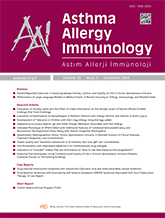


Objective: Many pioneers have mentioned that various organisms like bacteria, viruses, and fungi may complicate many allergic affections. This study aimed to show the association between bacterial infections and the determination of some immunological mediators in patients with skin allergies, among them total IgE and Specific IgE for Staphylococcus aureus dominated isolates from skin lesions of atopic dermatitis patients.
Materials and Methods: Eighty patients with skin allergies and twenty normal control individuals were included in this study. The study was done from October 2023 to January 2024 at the Department of Microbiology, College of Medicine, University of Anbar, Iraq. A skin swab and blood specimen were taken from each individual to be investigated. Total IgE and Specific IgE for Staphylococcus aureus dominated isolates from skin lesions of atopic dermatitis patients and control individuals using the ELISA test.
Results: Results revealed a significant difference between patients and control individuals in the titers of total IgE and Periostin, while there was no significant difference in the titers of IL-5. At the same time, results showed a significant correlation between basophils and total IgE, and a positive correlation between basophils and periostin as well as total IgE and periostin. Specific IgE to Staphylococcus aureus was detected in this study.
Conclusion: Bacterial infections concomitant with skin atopic dermatitis and other allergic reactions complicate these affections. So, total IgE, Periostin, and IL-5 undergo an increase. Detection of IgE specific to Staphylococcus aureus confirms that infections of different etiology can induce atopic reactions.